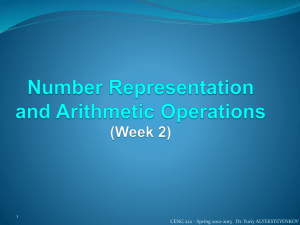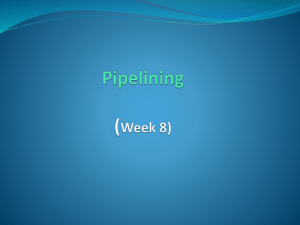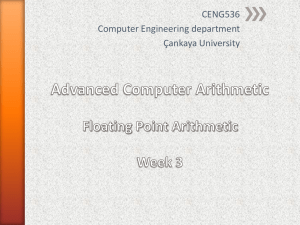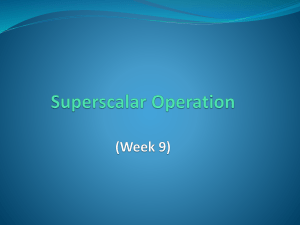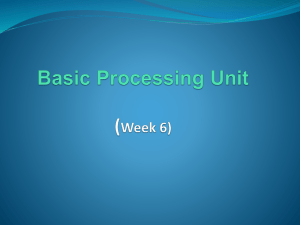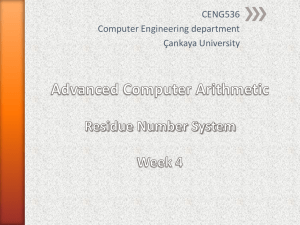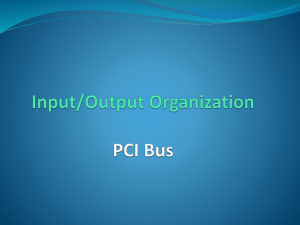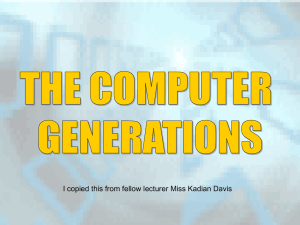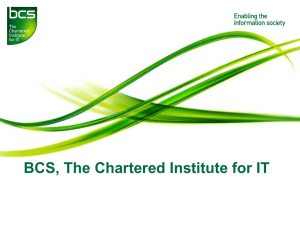CENG 222 COMPUTER ORGANIZATION
advertisement
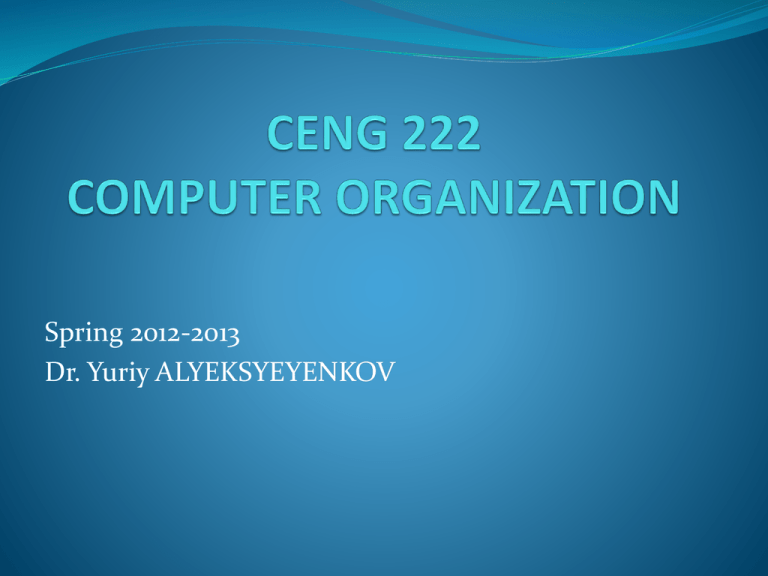
Spring 2012-2013 Dr. Yuriy ALYEKSYEYENKOV E-Mail Phone Hours Class 4, 5, 6 Class 1, 2, 3 Office Office Office Room Class Class Office 2 : yuriy@cankaya.edu.tr : +90 (312) 233 13 39 : Monday : Tuesday : Monday : Wednesday : Thursday 09:40 – 11:30 11:40 – 13:30 13:40 – 15:30 13:40 – 15:30 13:40 – 15:30 1, 2, 3 : L-A14 4, 5, 6 : L-A15 : L-220 CENG 222 - Spring 2012-2013 Dr. Yuriy ALYEKSYEYENKOV • Text Book: Structured Computer Organization, 5-th edition, Andrew S. Tannenbaum, Prentice Hall, 2006 Computer Organization and Embedded Systems, -th edition, Carl Hamacher, Zvonko Vranesich, Safwat Zaky, McGraw Hill, • Reference Material: Computer Organization and Architecture Designing for Performance, 7-th edition, William Stallings, Prentice Hall, 2006 Computer Organization and Architecture An Integrated Approach, Miles Murdocca and Vincent Heuring, John Wiley & Sons Inc., 2007 • Course Web Page http://ceng222.cankaya.edu.tr • Course Assistant Faris Serdar Taşel 3 fst@cankaya.edu.tr CENG 222 - Spring 2012-2013 Dr. Yuriy ALYEKSYEYENKOV 1. Attendance 2. Quizzes 3. Lab Work 4. Midterm 5% 15% 25% 20% Will cover the concepts learned thus far. Closed books, notes, etc. 5. Final 35% Will cover all the topics learned during the semester Closed books, notes, etc. Rules of the Game Attend every class Be on time Pay attention during class All work should be your own Ask questions anytime, but raise your hand Remember that the program language is English Grades are earned, not given 4 CENG 222 - Spring 2012-2013 Dr. Yuriy ALYEKSYEYENKOV The Zeroth Generation 5 CENG 222 - Spring 2012-2013 Dr. Yuriy ALYEKSYEYENKOV The Zeroth Generation (1642-1945) Blaise Pascal (1623 - 1662) 6 A working calculator machine was built in 1642. It was entirely mechanical, using gears. Addition and subtraction only. CENG 222 - Spring 2012-2013 Dr. Yuriy ALYEKSYEYENKOV The Zeroth Generation (1642-1945) Baron Gottfried Wilhelm von Leibniz (1646 – 1716) 7 Built thirty years after. Arithmetic operations: - Addition - Subtraction - Multiplication - Division It’s equivalent of fourfunction pocket calculator. CENG 222 - Spring 2012-2013 Dr. Yuriy ALYEKSYEYENKOV The Zeroth Generation (1642-1945) Charles Babbage (1792 – 1871) 8 Difference engine – could only add and subtract. Was designed to compute tables of numbers useful for naval navigation. The most interesting feature was its output method: it punched its results into a cooper engraver’s plate with a steel die. CENG 222 - Spring 2012-2013 Dr. Yuriy ALYEKSYEYENKOV The Zeroth Generation (1642-1945) Analitycal Engine and Punch Cards The mill could accept operands from the store, then process them, and finally return the result to the store. 9 It had four components: The Store (memory); The mill (computation unit); The Input Section (punched card reader); The output section (punched and printed output); Four arithmetic operations. Store consists of 1000 words of 50 decimal digits. It was general purpose. CENG 222 - Spring 2012-2013 Dr. Yuriy ALYEKSYEYENKOV The Zeroth Generation (1642-1945) She was the world’s first programmer. The programming language Ada® is named in her honor. Ada Augusta Lovelace (Daughter of the famed British poet Lord George Gordon Byron) 10 CENG 222 - Spring 2012-2013 Dr. Yuriy ALYEKSYEYENKOV The First Generation – Vacuum Tubes (1945 – 1955) 11 CENG 222 - Spring 2012-2013 Dr. Yuriy ALYEKSYEYENKOV The First Generation – Vacuum Tubes (1945 – 1955) ENIGMA – coder and encoder used by Germany during World War II. 12 First electronic computer COLOSSUS (1943) was designed only to read decoded messages from ENIGMA. (Alan Turing). It was dead end computer. CENG 222 - Spring 2012-2013 Dr. Yuriy ALYEKSYEYENKOV COLOSSUS (1943) 13 CENG 222 - Spring 2012-2013 Dr. Yuriy ALYEKSYEYENKOV The First Generation – Vacuum Tubes (1945 – 1955) ENIAC (Electronic Numerical Integrator And Computer). It consisted of 18000 vacuum tubes and 1500 relays. Weighted 30 tons and consumed 1400 kW of power. Designed by John Mauchley and J. Presar Eckert. Architecturally, the machine had 20 registers, each capable of holding a 10-digit decimal number. ENIAC was programmed by setting up 6000 multiposition switches and connecting a multitude of sockets with a variable forest of jumper cables. Project was finished at 1946. 14 CENG 222 - Spring 2012-2013 Dr. Yuriy ALYEKSYEYENKOV The First Generation – Vacuum Tubes (1945 – 1955) EDVAC (Electronic Discrete Variable Automatic Computer) known as machine were ideas of von Neumann were realized. Block diagram of the von Neumann architecture: MQ - multiplier quotient register; IR instruction register; IBR - instruction buffer register; MAR - memory address register; MDR - memory data register. The First Generation computers – experiments on hardware architecture. 15 CENG 222 - Spring 2012-2013 Dr. Yuriy ALYEKSYEYENKOV The First Generation – Vacuum Tubes (1945 – 1955) First industrial computer IBM 701. The 701 had 2048 36-bit words memory with two instructions per word. It was the first in a series of scientific machines that came to dominate the industry within a decade. Three years later come 704, which initially had 4096 words of core memory, 36-bit instructions and floating-point hardware. In 1958, IBM began production of its last vacuum tube machine, the 709, which was basically a beefed-up 704. 16 CENG 222 - Spring 2012-2013 Dr. Yuriy ALYEKSYEYENKOV The Second Generation – Transistors (1955-1965) 17 CENG 222 - Spring 2012-2013 Dr. Yuriy ALYEKSYEYENKOV The Second Generation – Transistors (1955-1965) In the late 40’s three American scientists named William Shockley, John Bardeen and Walter Brattain at Bell Labs, announced the creation of the first transistor. The first transistorized computer was built at M.I.T.’s Lincoln laboratory, a 16bit machine. The most interesting computers were produced by DEC (Digital Equipment Corporation) and IBM (International Business Machine) The First transistor (1948) For computers of this generation there were designed many new peripheral devices. 18 CENG 222 - Spring 2012-2013 Dr. Yuriy ALYEKSYEYENKOV The Second Generation – Transistors (1955-1965) The PDP-8 is a 12 bit single accumulator machine which can address up to 32K 12 bit words. It has 8 basic instructions and the PDP-8/E executes them in 1.2 microsecond for simple instructions to 4 microsecond for complex memory reference instructions. This gives the machine about a 0.5 MIPS rating. DEC computer PDP-8 (1965) 19 CENG 222 - Spring 2012-2013 Dr. Yuriy ALYEKSYEYENKOV The Second Generation – Transistors (1955-1965) (PDP-8 Peripheral Devices) The RK05J Disk Drive is a removable media hard drive with a total capacity of 1.6 million 12 bit words. The RX01/RX02 Disk Drive a removable media 8 inch floppy drive. The RX01 was the first generation drive dating to around 1975. The RX02 was a double capacity version around 1978. The RX02 double density drive stored 256k words or 512k bytes on a disk. 20 CENG 222 - Spring 2012-2013 Dr. Yuriy ALYEKSYEYENKOV The Second Generation – Transistors (1955-1965) (PDP-8 Peripheral Devices) The PC04 high speed paper tape reader/punch. Paper tape was an inexpensive method for storing and transferring data. PDP-8 TU10 1/2" tape drive 21 CENG 222 - Spring 2012-2013 Dr. Yuriy ALYEKSYEYENKOV The Second Generation – Transistors (1955-1965) (PDP-8 Peripheral Devices) The VR14 is a X/Y display monitor. Viewable Area 6.75 x 9 inches. ASR 33 Teletype Data Transfer Rate 10 characters per second, 110 baudl. 22 CENG 222 - Spring 2012-2013 Dr. Yuriy ALYEKSYEYENKOV The Second Generation – Transistors (1955-1965) (IBM 1401) IBM 1401 Data Processing System (1959). From the left: 1402 Card Read-Punch, 1401 Processing Unit, 1403 Parallel Printer. 23 CENG 222 - Spring 2012-2013 Dr. Yuriy ALYEKSYEYENKOV The Third Generation – Integrated Circuits (1965-1980) 24 CENG 222 - Spring 2012-2013 Dr. Yuriy ALYEKSYEYENKOV The Third Generation – Integrated Circuits (1965-1980) Nicknamed "the Mayor of Silicon Valley", cofounded Fairchild Semiconductor in 1957 and Intel Corporation in 1968. He is also credited (along with Jack Kilby) with the invention of the integrated circuit or microchip which fueled the personal computer revolution and gave Silicon Valley its name. In July 1959, he filed for U.S. Patent 2,981,877 "Semiconductor Device and Lead Structure", a type of integrated circuit. That was invention of the first integrated circuit Robert Norton Noyce (December 12, 1927 – June 3, 1990) 25 CENG 222 - Spring 2012-2013 Dr. Yuriy ALYEKSYEYENKOV The Third Generation – Integrated Circuits (1965-1980) IBM System/360. A family of computers. Contrasting with at-the-time normal industry practice, IBM created an entire series of computers (or CPUs) from small to large, low to high performance, all using the same instruction set (with two exceptions for specific markets). This feat allowed customers to use a cheaper model and then upgrade to larger systems as their needs increased without the time and expense of rewriting software. IBM was the first manufacturer to exploit microcode technology to implement a compatible range of computers of widely differing performance, although the largest, fastest, models had hard-wired logic instead. 26 CENG 222 - Spring 2012-2013 Dr. Yuriy ALYEKSYEYENKOV The Third Generation – Integrated Circuits (1965-1980) DEC PDP-11. A family of computers. 1971: The PDP-11/45 was an excellent computational tool for large multi-user, multi-task installations. Through memory management, memory could be expanded to 128K, which included a combination of bi-polar and MOS memory. Other features included a greatly expanded floating point processor. 1975: The PDP-11/70 represented the high end of PDP-11 architecture with the capacity for supporting the speed, addressing range and bandwidth required in large systems applications. It was the first PDP-11 to use cache memory. 27 CENG 222 - Spring 2012-2013 Dr. Yuriy ALYEKSYEYENKOV The Third Generation – Integrated Circuits (1965-1980) Development of Software 1 From its beginnings in the 1940s, writing software has evolved into a profession concerned with how best to maximize the quality of software and of how to create it. Quality can refer to how maintainable software is, to its stability, speed, usability, testability, readability, size, cost, security, and number of flaws or "bugs", as well as to less measurable qualities like elegance, conciseness, and customer satisfaction, among many other attributes. Computer hardware was application-specific. Scientific and business tasks needed different machines. Due to the need to frequently translate old software to meet the needs of new machines, high-order languages like FORTRAN, COBOL, and ALGOL were developed. Hardware vendors gave away systems software for free as hardware could not be sold without software. A few companies sold the service of building custom software but no software companies were selling packaged software. Totally were designed more than 100 different high-order languages, but now only few of them are in use. 28 CENG 222 - Spring 2012-2013 Dr. Yuriy ALYEKSYEYENKOV The Third Generation – Integrated Circuits (1965-1980) Development of Software 2 An operating system (OS) is a collection of software that manages computer hardware resources and provides common services for computer programs. The operating system is a vital component of the system software in a computer system. Application programs usually require an operating system to function. Time-sharing operating systems schedule tasks for efficient use of the system and may also include accounting for cost allocation of processor time, mass storage, printing, and other resources. Examples of popular modern operating systems include Android, BSD, iOS, Linux, Mac OS X, Microsoft Windows, Windows Phone, and IBM z/OS. All these, except Windows and z/OS, share roots in UNIX. 29 CENG 222 - Spring 2012-2013 Dr. Yuriy ALYEKSYEYENKOV The Fourth Generation – Very Large Scale Integration (1980 - ?) 30 CENG 222 - Spring 2012-2013 Dr. Yuriy ALYEKSYEYENKOV The Fourth Generation – Very Large Scale Integration Microprocessor A microprocessor incorporates the functions of a computer's central processing unit (CPU) on a single integrated circuit (IC), or at most a few integrated circuits. It is a multipurpose, programmable device that accepts digital data as input, processes it according to instructions stored in its memory, and provides results as output. It is an example of sequential digital logic, as it has internal memory. Microprocessors operate on numbers and symbols represented in the binary numeral system. The advent of low-cost computers on integrated circuits has transformed modern society. General-purpose microprocessors in personal computers are used for computation, text editing, multimedia display, and communication over the Internet. Many more microprocessors are part of embedded systems, providing digital control of a myriad of objects from appliances to automobiles to cellular phones and industrial process control. 31 CENG 222 - Spring 2012-2013 Dr. Yuriy ALYEKSYEYENKOV The Fourth Generation – Very Large Scale Integration Milestones of the microprocessors Intel 4004 – bit-slice 4-bit microprocessor (1971). Intel 8080 – 8-bit microprocessor (1974). Intel 8088 – 16-bit microprocessor (1979). The base of first Personal Computer ....... Pentium – 32-bit microprocessor (1993). 32 CENG 222 - Spring 2012-2013 Dr. Yuriy ALYEKSYEYENKOV The Fourth Generation – Very Large Scale Integration RFID Chips RFID stands for Radio-Frequency IDentification. The acronym refers to small electronic devices that consist of a small chip and an antenna. The chip typically is capable of carrying 2,000 bytes of data or less. The RFID device serves the same purpose as a bar code or a magnetic strip on the back of a credit card or ATM card; it provides a unique identifier for that object. And, just as a bar code or magnetic strip must be scanned to get the information, the RFID device must be scanned to retrieve the identifying information. 33 CENG 222 - Spring 2012-2013 Dr. Yuriy ALYEKSYEYENKOV History of Computer Designing 34 CENG 222 - Spring 2012-2013 Dr. Yuriy ALYEKSYEYENKOV Computers in the USSR First generation Soviet computer MESM (Small Electronic Computing Machine) was designed by S. Lebedev in Kiev (1951). 6000 vacuum tubes. Clocking frequency – 50 kHz; rating – 50 op/sec; 16-bit; RAM memory 32 data words, 64 instruction words. 35 CENG 222 - Spring 2012-2013 Dr. Yuriy ALYEKSYEYENKOV Computers in the USSR BESM (Big Electronic Computing Machine) (1952) First generation Soviet computer BESM was designed by S. Lebedev in Moskov (1952). 5000 vacuum tubes. Clocking frequency – 100 kHz; rating – 10 000 op/sec; 39-bit floating point ALU; RAM memory 32 data words, 64 instruction words. External memory – magnetic drum 1024 words, magnetic tape 120 000 words Then were manufactory produced models BESM-2, and versions for military applications M-40, M-50 36 CENG 222 - Spring 2012-2013 Dr. Yuriy ALYEKSYEYENKOV Computers in the USSR BESM-6 (Big Electronic Computing Machine) (1965) Second generation Soviet computer BESM -6. Rate 1 MIPS. 48-bit registers and ALU. Address bus 15 bit. Clock frequency 10 MHz. 37 CENG 222 - Spring 2012-2013 Dr. Yuriy ALYEKSYEYENKOV Computers in the USSR MIR-2 (Machine for Engineering Computations) (1969). 12 000 op/sec. RAM – 8000 13-bit words. ROM 1,6x106 bit. Promin (Beam) (1963) 38 CENG 222 - Spring 2012-2013 Dr. Yuriy ALYEKSYEYENKOV Computers in the USSR SETUN the unique computer that work in system of base three (1959-1970). Density of information is described by equation where X – base of the system. The optimal base is constant e = 2,718281828459045. Trite – name of the digit in this system. 39 CENG 222 - Spring 2012-2013 Dr. Yuriy ALYEKSYEYENKOV Computers in the USSR Soviet military super computer 5Э53 – designed for anti-missile defense system A-35 (19671972). Work in residue number system. Rate 40 MIPS. Clocking frequency 6 MHz. RAM 10 Mbit. ROM 2,9 Mbit. External memory 3 Gbit. Harvard architecture. Pipelined arithmetic. 40 CENG 222 - Spring 2012-2013 Dr. Yuriy ALYEKSYEYENKOV Computers in Russia Russian supercomputer “Lomonosov” (2009). 6654 computing nodes, 94000 cores, rate 1,37 pico flops. June 2011 – 13 position on Top500 of the most powerful computers all over the world. 41 CENG 222 - Spring 2012-2013 Dr. Yuriy ALYEKSYEYENKOV Computers in Russia Russian microprocessor ELBRUS (ExpLicit Basic Resources Utilization Scheduling) (2010). 64 бита — 4,0 GFLOPS, 32 бита — 8,0 GFLOPS, 4 cores for DSP, 2 processor cores… 42 CENG 222 - Spring 2012-2013 Dr. Yuriy ALYEKSYEYENKOV
